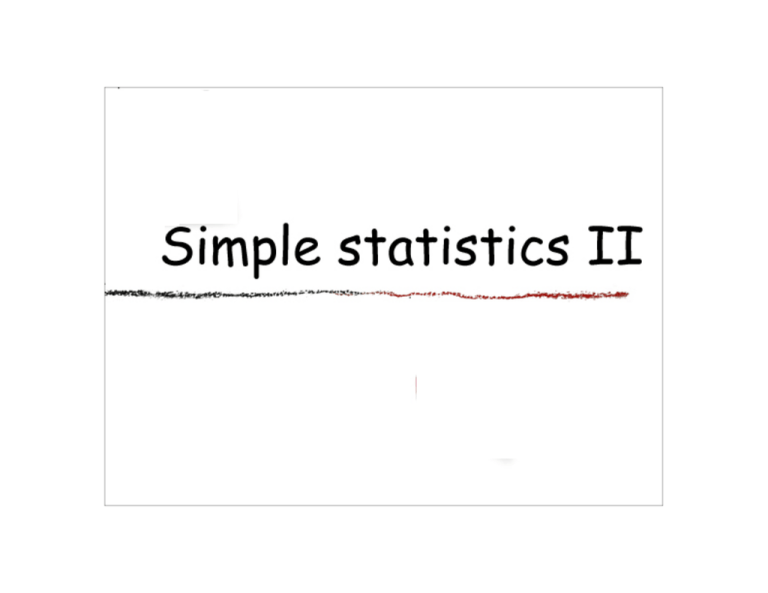Document 13626379
advertisement

Statistics has 3+ components Probability calculations Descriptive statistics Data analysis Statistical inference Inferential statistics Models .... Inferential statistics, Why? • Our measurements have error – Random error – Measurement error – Intervening variables – Etc. Inferential statistics, Why? • We want to make inferences beyond our sample • Statistics organizes & set the “rules” by which we can draw conclusions • We usually test things we think will “work” – Statistics help protect us against ourselves Going beyond descriptions • The main issue is variance! • The question we ask is how large or likely is the effect relative to the variance we have. Sampling & probability • In Binomial distributions there are two possible outcomes. – What is the probability for 5 boys – What is the probability for 4 out of 5 being boys? • P(r successes) = (n!/r!) * pr * qn-r Hypothesis testing #1 • Using the binomial distribution • If a family has 4 boys, are they likely to have a boy or girl next time? • What about 5 or 6 boys? From binomial to normal As N increases and p = q, the binomial becomes close to the normal Another test Usually 6% of MIT students pass 15.301. At Sloan (out of 400 students) 42 have passed 15.301. Is this random? Are the Sloan students better? What do we need for an answer: Expected mean (µ)= np 2 Variance (σ ) = npq Z = (xi - µ) / σ µ = 400*6/100 = 24; σ = 4.8 Z (41.5) = (41.5 - 24)/4.8 = 3.64 Using the normal table, z = 3.64 = p 0.0001 Statistical tests • • • • T-test ANOVA Linear Regression Non-parametric tests One sample t test Mean diff t= √ µ-M ∑(xi - µ)2 n-1 Standard deviation √ n What do you do with “t” Compare it to the “t table” When there is more data, the t distribution gets closer to normal Example: Observation 1 2 3 4 5 6 7 all Aggressive 24 22 23 18 17 16 20 140 xi - m 4 2 3 -2 -3 -4 0 0 (xi - m)2 16 4 9 4 9 16 0 58 Example: H0: average is 16 H1: average ≠16 σ= √ 2 ∑(xi - µ) t=σ n-1 µ-M √n = 3.11 = 3.42 two samples t test Test for independent samples t= √ (µ1 - µ2) - (M1 - M2) n1 σ12 + n2 σ22 n1 + n2 -2 ( n1 + n2 n1 x n2 ) Example Who eats more lollipops males of females? 7 females; 5 males followed for a month Females: µ = 27, σ2 = 29.2 Males: µ = 19, σ2 = 24.57 Is there a difference? Calculating ... t= √ (27 - 19) - (0) 5 x 24.57 + 7 x 29.2 5 + 7 -2 ( 5+ 7 5x 7 ) = 2.42 two samples t test Test for dependent samples t= (within diff) - (expected diff) sd of diff √n Example Does the sun creates freckles? Each ss has one side of the body in the sun H0 sun side ≤ non-sun side H1 sun side > non-sun side Data Subject 1 2 3 4 5 6 7 8 9 all sun 6 12 3 4 7 9 4 0 4 shade 8 5 2 6 0 10 4 2 3 diff -2 7 1 -2 7 -1 0 -2 1 9 d-m -3 6 0 -3 6 -2 -1 -3 0 0 (d - m)2 9 36 0 9 36 4 1 9 0 104 Calculating ... σ= √ 104 8 = 3.606 (1) - (0) t = 3.606 √9 = 0.831 Summary t test as an example of inferential statistics Mean differences relative to variance







